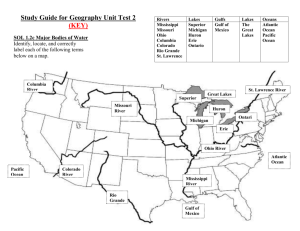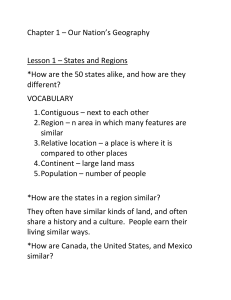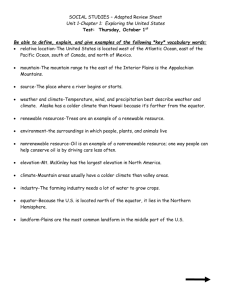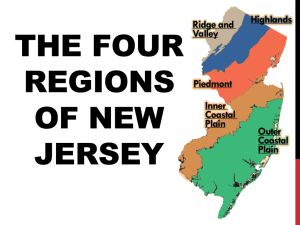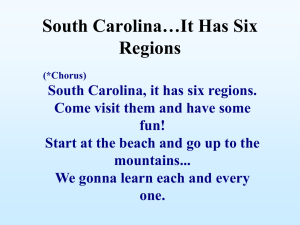USI.2 Geography
advertisement
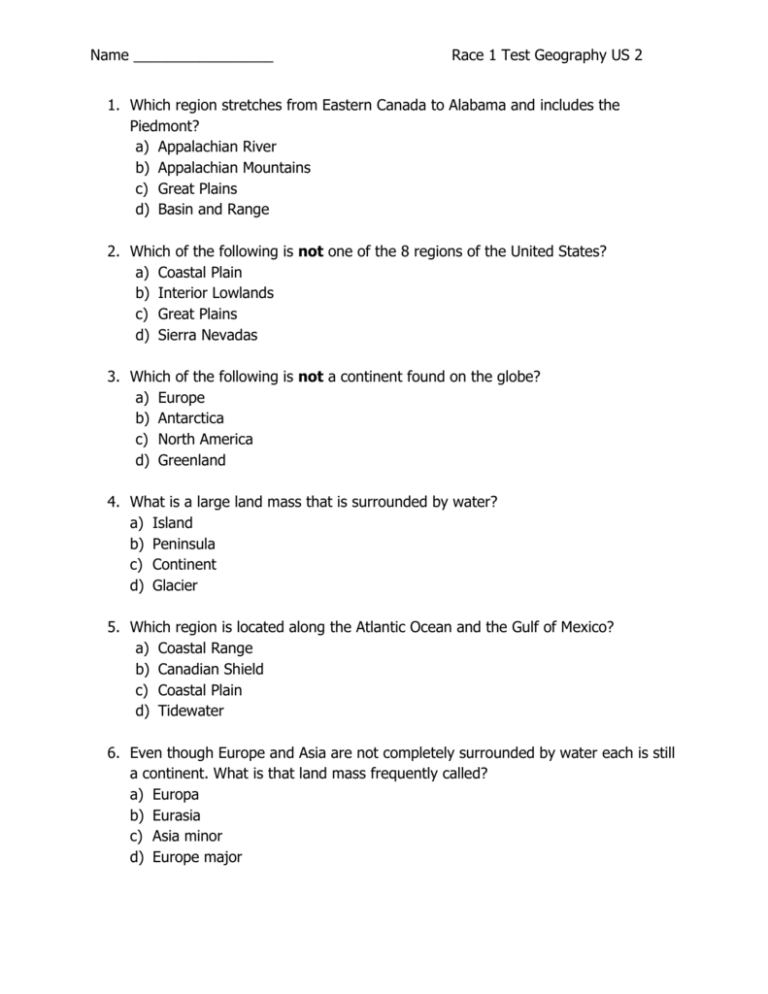
Name _________________ Race 1 Test Geography US 2 1. Which region stretches from Eastern Canada to Alabama and includes the Piedmont? a) Appalachian River b) Appalachian Mountains c) Great Plains d) Basin and Range 2. Which of the following is not one of the 8 regions of the United States? a) Coastal Plain b) Interior Lowlands c) Great Plains d) Sierra Nevadas 3. Which of the following is not a continent found on the globe? a) Europe b) Antarctica c) North America d) Greenland 4. What is a large land mass that is surrounded by water? a) Island b) Peninsula c) Continent d) Glacier 5. Which region is located along the Atlantic Ocean and the Gulf of Mexico? a) Coastal Range b) Canadian Shield c) Coastal Plain d) Tidewater 6. Even though Europe and Asia are not completely surrounded by water each is still a continent. What is that land mass frequently called? a) Europa b) Eurasia c) Asia minor d) Europe major Name _________________ Race 1 Test Geography US 2 7. Which region is wrapped around the Hudson Bay like a horseshoe? a) Coastal Range b) Coastal Plain c) Appalachian Mountains d) Canadian Shield 8. Which region contains rugged mountains that stretch along the Pacific Coast from Canada to California? a) Appalachian Mountains b) Canadian Shield c) Rocky Mountains d) Coastal Range 9. Which region in North America has broad lowlands that allows for excellent harbors and ports? a) Coastal Range b) Canadian Shield c) Coastal Plain d) Gulf of Mexico 10. Which region is known for its old, eroded mountains (old rounded mountains) and is the oldest mountain range in North America? a) Coastal Range b) Appalachian Mountains c) Rocky Mountains d) West Andes 11. Which region is characterized by hills that were worn by erosion and hundreds of lakes carved by glaciers? a) Coastal Range b) Canadian Shield c) Rocky Mountains d) Coastal Plain Name _________________ Race 1 Test Geography US 2 12. Which region has grasslands, but starts as flat land that gradually increases? a) Interior Lowlands b) Great Plains c) Basin and Range d) Coastal Plain 13. Which region contains the Continental Divide which sets rivers flowing in one direction or another? a) Interior Lowlands b) Basin and Range c) Rocky Mountains d) Coastal Range 14. Which region is best known for its fertile valleys? a) Coastal Plain b) Interior Lowlands c) Canadian Shield d) Coastal Range 15. Which of the following is not a characteristic of the Interior Lowlands? a) Rolling flatlands with many rivers b) Broad river valleys c) Old, eroded mountains d) Grassy hills 16. Which of the following is not a characteristic of the Rocky Mountains? a) Rugged mountains b) Stretch from Alaska to almost Mexico c) Oldest mountain range in North America d) High elevations 17. Which region includes Death Valley and areas of varying elevations containing isolated mountain ranges? a) Great Plains b) Basin and Range c) Coastal Range d) Interior Lowlands Name _________________ Race 1 Test Geography US 2 18. Which ocean pairing below helps and has helped the United States in history? a) Pacific and Indian b) Atlantic and Indian c) Pacific and Atlantic d) Arctic and Atlantic 19. What are 7 major rivers important to United States? a) Ohio, St. Lawrence, Missouri, Mississippi, Arkansas, James, Potomac b) Mississippi, Missouri, Colorado, Columbia, Rio Grande, Ohio, St. Lawrence c) James, York, Hudson, East, Nile, Amazon, Niger d) Ohio, Missouri, Mississippi, Colorado, North, South, Columbia 20. Which of the following was not centered around water? a) Trade b) Settlement c) Transportation d) Taxes 21. Which is described as being a highway for explorers, early settlers, and later immigrants? a) Southern Ocean b) Pacific Ocean c) Atlantic Ocean d) Arctic Ocean 22. What connects regions, forms borders, and create links to other areas? a) Peninsulas b) Continents c) Islands d) Bodies of water 23. What does the location of the Atlantic and Pacific coasts provide? a) Drinking water b) Access to other areas of the world c) A fun place to take families on vacation d) Provided a pathway for settlement 24. Why were the Great Lakes important? a) Good for fishing and recreation b) Created inland port cities c) Made it easy to travel from New York to Michigan d) More difficult for people to escape harsh rule Name _________________ Race 1 Test Geography US 2 25. Who explored the Columbia River? a) Coronado b) Lewis and Clark c) The Spanish d) The French 26. Which river forms a border with Mexico and the United States? a) Mississippi b) Missouri c) Ohio d) Rio Grande 27. Why was the Ohio River important? a) It was settled primarily by the Indians b) It was the gateway to the west c) It served as an artery for exploration d) It was an escape route for slaves 28. Which 2 rivers were transportation arteries for farm and industrial products? a) Ohio and Colorado b) Columbia and Rio Grande c) Mississippi and Missouri d) Ohio and Mississippi 29. Who explored the Colorado River? a) The French b) The Spanish c) The English d) The Indians 30. Which ocean was an early exploration route? a) The Indian b) The Arctic c) The Southern d) The Pacific 31. Which body of water provided the French and the Spanish with exploration routes to Mexico and other parts of America? a) Pacific Ocean b) Gulf of Alaska c) Atlantic Ocean d) Gulf of Mexico
